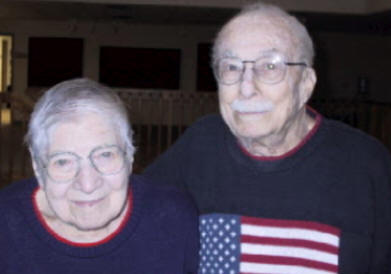Esther and Edwin Prentke

Edwin Prentke was born in early 1904 -- less
than three months following the Wright brothers flight at Kitty Hawk and two
years before Lee DeForest invented the vacuum tube, the first active
electronic component.
(1902 telegram congratulating Ed's parents on their marriage)
Esther Green was born in late 1907.
Ed soon was pursuing his passion for cars.
Following graduation from East Tech High School in Cleveland, Ohio, Ed began his electrical engineering education at Case School of Applied Science. The summer following his freshman year, Ed attended Camp Case with his classmates to fulfill the requirement of the day. There they stayed in tents and learned to survey, to identify trees by their bark, and related skills. Letters from Camp Case.
Ed's frustration at early cars being available only in black drove him to paint his car yellow. His affinity for yellow cars carried through to the purchase of his last car, a bright yellow 2003 Mustang convertible.
Esther was a very good typist, winning awards in 1923 and 1924.
When Ed graduated from Case in 1926, electrical engineering jobs were scarce. It was the era of the radio, and Ed's first work was door-to-door radio service. When his sweetheart Esther Green informed him that a prerequisite to marriage was that Ed have his own establishment, Ed rented a storefront for his business. They were married in 1933.
Here is Ed's business card:
and on the back he had written to Esther
Ed was an avid photographer and joined the Cleveland Photographic Society.
Ed took this photo of Charles and Anne Morrow Lindberg at the 1929 Cleveland Air Races just two years after the first non-stop trans-Atlantic flight.
Ed's enthusiasm for photography led to the addition of cameras and photographic supplies to the business. Eventually Prentke's, Inc. became dedicated to this area of sales and service.
In addition to the photographic shop, Ed was involved in other activities. (Accounts of this era included frequent references to "Esther ran the store".) He taught electronics at both Case and Fenn College, now Cleveland State University. He wrote self-study courses for Cleveland Institute of Electronics. During WWII, he was a partner in a machine shop working for the war effort.
Esther played the piano and Ed played the organ. Ed was once part of a group of eleven organs and participated in a public performance.
They were a handsome couple.
Both Ed and Esther became avid sailors. They bought a wooden 28' ketch around 1945, in which they sailed the Great Lakes.
|
|
|
|
By the mid fifties, Ed and Esther were thinking of retirement. They sold the camera store, but soon realized that retirement was not a good idea for them. Through a connection with physiatrist Charles Long, M.D., both Ed and Esther secured employment at Highland View Hospital, the Cuyahoga County rehabilitation facility. They worked in a research lab. Ed also built some early assistive technology for high level spinal cord injury patients in the hospital.
Around this time, James Reswick, Ph.D. was director of the Engineering Design Center at Case (by then Case Institute of Technology, now part of Case Western Reserve University). Drs. Long and Reswick collaborated on a federally-funded research program investigating the control of upper extremity powered orthoses. Through this program, Ed got acquainted with Case engineering students. One of them was Barry Romich, and in 1966 Prentke Romich Company (PRC) was formed as a spinoff of this research program.
|
|
|
Among early projects were a device to limit the acceleration of powered wheelchairs, which otherwise started with a jerk because this was prior to electronic controls. A paraplegic patient in the hospital helped to design and build the first communication device for a man who had had a stroke. It was based on a discarded teletype machine.
Ed and his work were frequently featured in the local media.
Ed continued to contribute to the growth of PRC until 1979, when at the age of 75 he retired from PRC. (He continued his hospital employment.) PRC has continued to grow and has touched the lives of many tens of thousands of people with disabilities around the world.
Following a national search for a "Renaissance tinkerer" in 1982, Brandeis University presented Ed with the Distinguished Service Award. The inscription reads:
"Your technological wizardry
liberates the physically disabled
and your abiding faith in their total humanity restores their
dignity."
Ed continued full time employment at the hospital until he was nearly 88. Here are some additional items:
1909 Hough Avenue house
1923 Radio License renewal Front and Back
ca. 1969 article from the JCRC newsletter on early technology for patients
1982 PRC Current Expressions article on the Brandeis award
1988 Case Alumnus magazine
ca. 1992 Ed's recollections
1929 car mentioned above
1997 Cleveland Plain Dealer article on Ed's "Teflon-coated retirement"
2001 Case Alumnus magazine
Some Prentke philosophy
Prentke wardrobe
